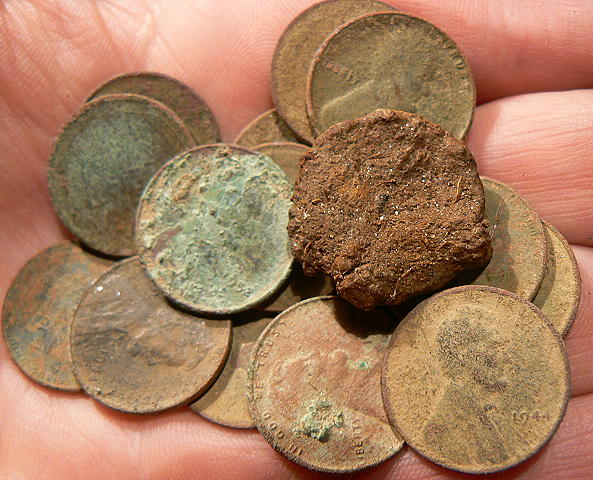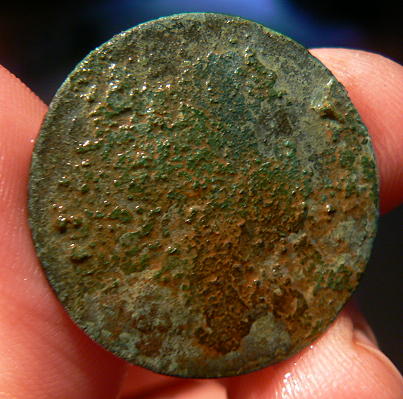Tuesday I didn’t have alot of time to hunt, but it was back to the 7 silver/cache site of recent entries to clean up that zone, and hopefully make some progress in the second zone of the site.
Neither ended well. The edge of the first/cache zone was a steep embankment of a 7 silver zone, and should have yielded 1 or 2 silvers. It didn’t. Too bad. Didn’t even yield a wheatie. It should have.
Onto the second zone, which I’ve done a couple of fruitless prospecting runs in, but today was transects at various angles, and specific grids, and again bupkis, except for a singe wheatie. Not even any clad or deep high tones. And this is a zone I had high hopes for, sort of like the 65 silver site of earlier this year. Too bad those days just ain’t coming back.
Wednesday was back to the same site to close the second zone, which had produced exactly one wheatie, and zero silvers — more transects and random grids, and I hit a hot zone near yesterday’s wheatie. All of the sudden I couldn’t swing the coil without hitting a wheatie. It was unbelievable. And dammingly frustrating as well, as I couldn’t pull one damn silver, while pulling 13 wheaties from this zone. Are you kidding me?
That blob on the top is a steelie, only the second one I’ve ever pulled. They are a rarer find than even seated coins, at least in my experience, and can only be found in a spill with other coins. Should I be happy about such a rare find? Go away.
So, what was going on here? Why such a high density of wheaties (actually the highest I’ve ever seen), in an otherwise dead zone? Who cares? If it was silver, I’d care, and write something intelligent; at this point I’m just pissed.
(As it turns out, and of course I composed the entry in my head expecting to find silver, the wheatie zone was a section of green grass, while the dead zone (the vast majority of the site), was brown, cause it hasn’t rained around here since Jefferson was president (which, BTW, adds to the frustration, like digging in cement)
Why was this? Correlation is not causality, but why so many wheaties under the green grass, and none under the brown grass? Looking for a causative factor — a) the dirt under the green grass is wetter, and therefore conducts better b) the green grass happened to be under a large tree (it was green cause the tree protected it from the sun), and its always easier to find older coins in shady spots rather than sunny spots (cause less grass, and hence less topsoil, is produced in such zones), c) as it turns out, the green section was near a Victorian era house by the edge of the property, and while it seems unlikely there would be so much spill from this property, especially when there was no spill in similarly situated brown sections, it is certainly possible. It is also possible the competition was afraid to hunt to close to the property line or did not know where it was.
Who knows? Who cares? Does it matter if silver is not produced? Of course not. But, I’m always thinking like this, and once in a while, said thinking solves the site, and produces silver in an optimal way. Too bad it it ended badly this time).
Anyway, after that frustration, its onto the main zone of the park, and its a few more wheaties. All deep and hard. A total of 16 consecutive wheatiies without 1 f**king silver coin. That’s close to a record for me, and given my career ratio of 2.4:1, I feel totally hosed.
So, I table the site. I think I need to come back after a good, heavy rain. There should be silver here — all the tells are in, but the bone dry dirt may be hiding them. Who knows? Still doesn’t explain the green zone. I have no explanation for that. Sometimes you just have to say — “its one of those things”.
Thursday was simply to close out an 11 silver site, which I first struck silver in the fall of 2010, got another at the end of 2012, and got a few more this winter, and this summer. I didn’t have much time, and just wanted to close out one small zone that remained. I got a colonial buckle, but nothing else old. Was a nice site tho, farewell farewell.
Today I had to stay close to home, and had nowhere really to go for a couple of hours, so I did something a bit different — went to a 70s era park where the aerials show it fully completed by 71, and construction starting in 58. The neighborhood was fully developed in the 58 aerials. Of course, you ain’t gonna find something old here, but you may snag a barely legal silver or two.
(OTOH, my best find ever, an 1800 draped bust half dime, was found in a park built in the 80s. The theory here is you have to hit these sites once in a while cause the competition ignores them. At least that was my theory, and given I found that half dime in 2010, and nothing that good since (and I’d been avoiding such sites), why not?)
Of course, I ended up finding something old, either a 1777 or 1787 King George III copper. Rather have the barely legal rosie, but here it is, FWIW.
What a treasure. Some folks actually get excited about digging these. More power to them.
Well, I think this is my worst week since I got the E-Trac. Of course, some of it was bad luck, some of it was work constraints restricting how far I could travel, but whatever it was, it sucked.
Maybe next week will be better, we’ll see.



Yuck, what an terrible week! Any consolation mine sucked too, but I wasn’t looking for silver. Hope your hunts improve soon! I have a feeling they will.
The dry grass comments reminded me of a discovery I made recently while re-examining a Google overlay for an old park in a small town nearby. Certain sections are very nice digging, others are like concrete. By far the most coins have come from the soft areas, but not just because they are easier to dig. The Etrac thinks the coins 2 inches deep in the rock-hard are actually 8 inches deep. Its weird. But the big kicker is that the aerial photos from 1938 show the exact same pattern of green grass and dry grass that exists today and the dry areas correspond to the rock-hard dirt. Meaning this dirt hasn’t been mixed since the 1930s and this has shown me some key “green” areas that I have not yet worked thoroughly enough.